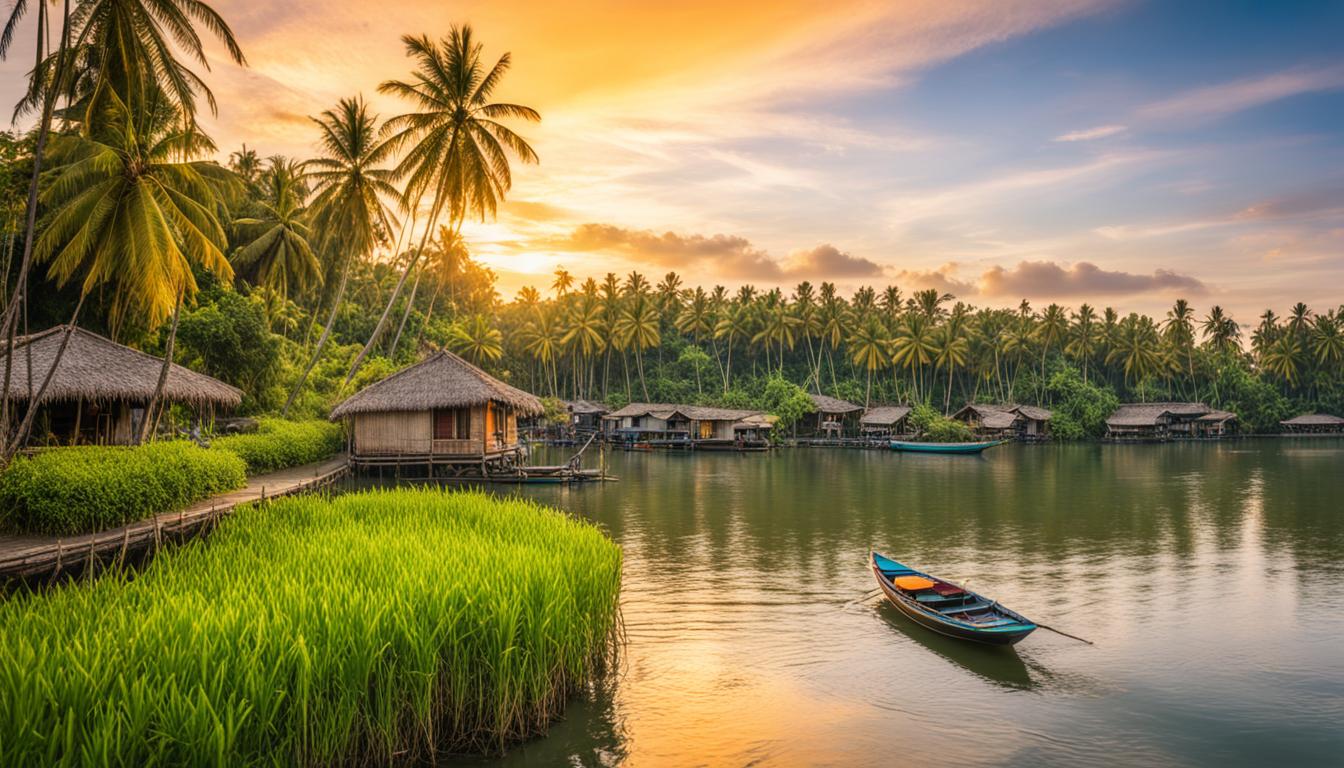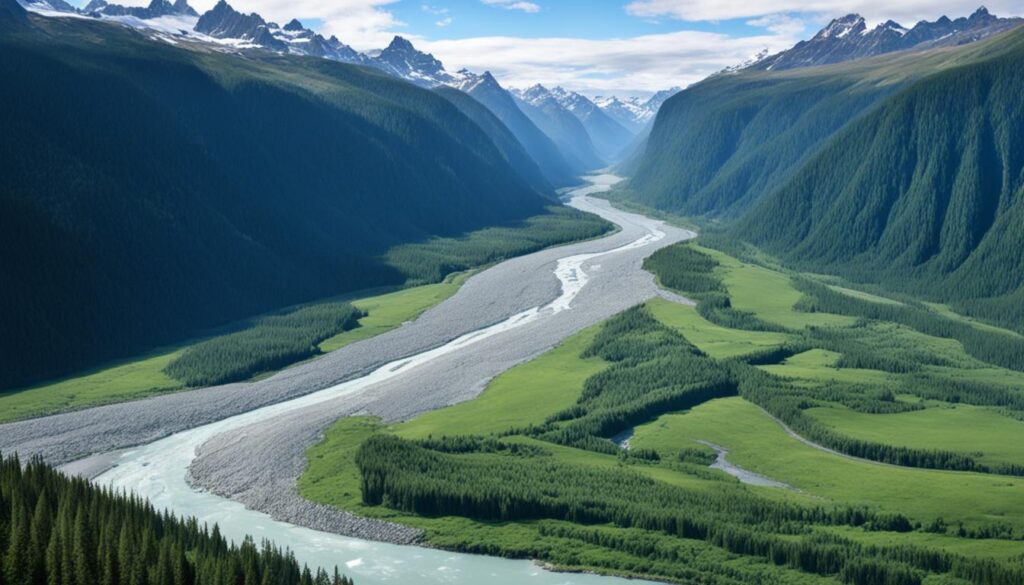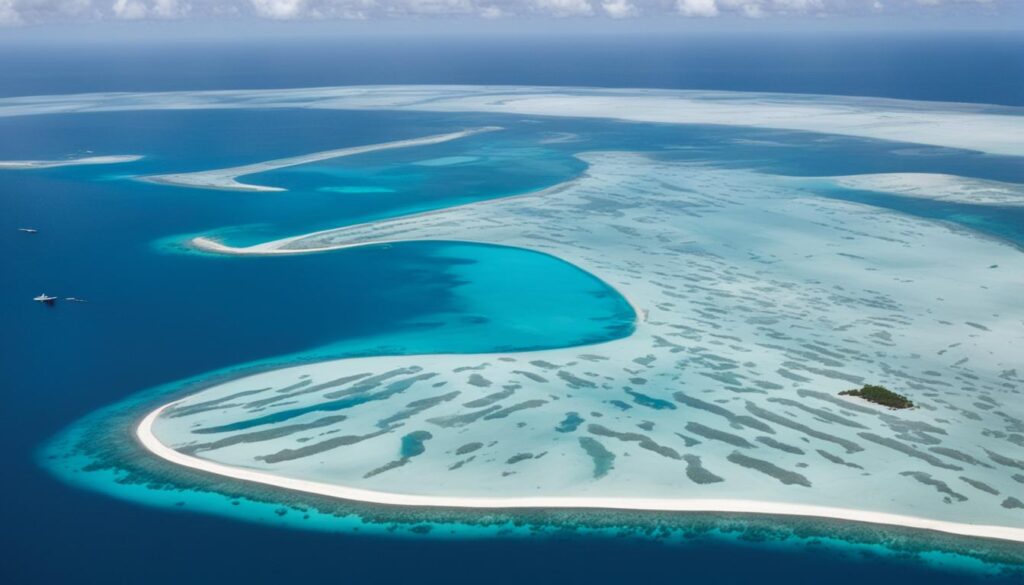
Vanishing Wonders: Places That Will Disappear by 2050
Did you know that several iconic and breathtaking locations around the world are at risk of disappearing within our lifetime? These disappearing locations, known as vanishing landmarks, are endangered destinations that may be gone by 2050. With the impacts of climate change and human activities becoming increasingly visible, it is crucial to explore and cherish these at-risk travel spots before they are lost forever.
Majuli Island In India
Majuli Island, once the largest river island in India, is now facing the threat of disappearance. Disastrous flooding and massive erosions have caused the island to shrink from 1200 sq km to less than 400 sq km. This significant reduction in size puts at risk the unique Assamese culture that thrived on the island and its stunning natural beauty. With projections indicating that Majuli Island might disappear by 2030, now is the time to visit and appreciate this melting pot of culture before it becomes a mere mention in history books.
The Disappearing Treasure of Assamese Culture
The Assamese culture, deeply rooted in Majuli Island, is in grave danger due to the island’s submerging. Majuli is known for its vibrant festivals, traditional crafts, and unique performing arts. The erosion and disappearing landmass threaten to erase these precious cultural expressions from existence. Visitors have the opportunity to experience the raw beauty and authenticity of the Assamese culture before it fades away forever.
“Majuli Island is a place where time seems to stand still. Its disappearing landscape serves as a stark reminder that we must preserve and cherish our natural and cultural heritage before it’s too late.” – Local Resident
A Haven for Nature Lovers
Home to diverse flora and fauna, Majuli Island offers a breathtaking natural spectacle that is rapidly vanishing. The lush greenery, meandering rivers, and the majestic Brahmaputra are sights that may soon be lost forever. Exploring the island’s wetlands and biodiversity-rich areas provides visitors with an unforgettable opportunity to connect with nature and witness the impacts of erosion firsthand.
Preserving Majuli Island’s Legacy
The rapid erosion of Majuli Island calls for immediate action to protect and preserve its fragile ecosystem. Efforts are underway to restore the island’s damaged areas, build embankments, and develop sustainable tourism practices. By supporting these initiatives and spreading awareness about Majuli’s plight, we can contribute to safeguarding this cultural and ecological treasure for future generations.
The Great Barrier Reef In Australia
The Great Barrier Reef, the world’s largest coral reef system, is under severe threat due to climate change. Rising ocean temperatures have caused widespread coral bleaching, where corals turn white and become vulnerable to mass die-offs.
This incredible underwater wonder is a must-visit before we lose the vibrant colors and biodiversity it holds.
“The Great Barrier Reef is not just a collection of individual reefs; it is a complex ecosystem that supports a wide variety of marine life, including hundreds of species of corals, fish, and other organisms. The reef’s vibrant colors and unique biodiversity make it one of the most awe-inspiring natural wonders on the planet.”
The Great Barrier Reef has already lost more than 50% of its original size, and if current conditions persist, it could completely vanish by 2030. This would be a devastating loss not only for Australia but for the entire world.
If you’ve ever dreamed of snorkeling or diving among colorful coral formations teeming with marine life, now is the time to visit the Great Barrier Reef. Witness the mesmerizing beauty of this underwater paradise before it fades away.
Threats to the Great Barrier Reef
The Great Barrier Reef faces several threats that contribute to its decline:
- Rising ocean temperatures: As global temperatures continue to rise, so do the temperatures of the ocean. Higher water temperatures increase the stress on coral reefs, leading to coral bleaching and eventual death.
- Ocean acidification: Increased carbon dioxide levels in the atmosphere are absorbed by the ocean, resulting in acidification. This makes it harder for corals to build their calcium carbonate skeletons, weakening their overall structure.
- Pollution: Agricultural runoff, coastal development, and industrial activities contribute to pollution that can smother coral reefs, disrupt their delicate balance, and inhibit their ability to recover from stress.
- Overfishing: Unsustainable fishing practices can disrupt the ecological balance of the reef, affecting the overall health and resilience of the ecosystem.
It is crucial that we take immediate action to protect and preserve the Great Barrier Reef. Governments, organizations, and individuals all have a role to play in reducing carbon emissions, implementing sustainable fishing practices, and taking steps to minimize pollution and runoff.
By working together, we can ensure that future generations have the opportunity to experience the breathtaking beauty and remarkable biodiversity of the Great Barrier Reef.
Glacier National Park In Montana
Glacier National Park, nestled in the majestic landscapes of Montana, is a treasure trove of natural beauty. However, this pristine wilderness is facing a grave threat – the rapid melting of its glaciers. Over the past 80 years, these once magnificent ice formations have dwindled from 150 to a mere 25.
Research suggests that if we don’t take immediate action, Glacier National Park’s glaciers could vanish entirely within the next 15 years. This decline not only signifies the loss of a remarkable geological wonder but also raises concerns about the future availability of essential water resources.
This heartbreaking transformation serves as a poignant reminder of the profound impacts of climate change. The declining ice sheet within Glacier National Park is a visual representation of our changing planet, urging us to reconsider our actions and strive for a more sustainable future.
Before these glaciers melt away, immerse yourself in the awe-inspiring landscapes that they carve with their icy touch. Witness the grandeur of snow-capped peaks, crystal-clear lakes, and lush alpine meadows. Capture the stillness and tranquility of this remarkable place, allowing its natural beauty to leave an indelible mark on your soul.
| Glacier Name | Current Size (acres) |
|---|---|
| Grinnell Glacier | 356 |
| Siyeh Glacier | 524 |
| Sperry Glacier | 259 |
| Boulder Glacier | 182 |
As you explore Glacier National Park, remember that the clock is ticking for these incredible ice formations. Seize the opportunity to bear witness to their waning presence and the raw power of nature. Let the serenity of the landscape inspire you to become an advocate for environmental preservation, so future generations can enjoy the wonders of this national park and all the natural beauty it holds.

Maldives In Indian Ocean
The Maldives, known for its heavenly beauty and stunning island resorts, faces an existential threat from global warming and rising sea levels. With an average ground level of only 2.3 meters and 1.4 meters above sea level, the Maldives is the world’s lowest-lying country. Scientists predict that by 2035, the Maldives could be the first nation to submerge in the ocean completely. Don’t miss the opportunity to visit this dream holiday destination before it disappears beneath the waves.

Why is the Maldives at risk?
The Maldives consists of a chain of over 1,000 islands, with the majority of its population settled in low-lying areas. As global warming leads to the melting of polar ice and the expansion of ocean waters, the Maldives is particularly vulnerable to the rising sea levels. The gradual sinking of the islands and increased flooding events pose a significant threat to the nation’s existence.
The impact of rising sea levels
Rising sea levels not only endanger the Maldives’ physical infrastructure but also its delicate ecosystem and unique biodiversity. The country’s coral reefs, which are vital for sustaining marine life and protecting coastlines from erosion, are at risk of being submerged and destroyed. Additionally, the Maldives relies heavily on tourism as a major source of revenue, and the disappearance of its pristine beaches and underwater wonders could have devastating economic consequences.
“The Maldives, with its turquoise waters, white sandy beaches, and vibrant marine life, is a true paradise on Earth. However, unless immediate action is taken to mitigate the effects of climate change, this heavenly destination could be lost forever.”
Preserving the Maldives for future generations
The Maldives Government has been taking proactive measures to address the challenges posed by rising sea levels. They have implemented initiatives such as building artificial islands and constructing seawalls to protect vulnerable areas. However, the scale of the problem requires collective global efforts in reducing greenhouse gas emissions and combating climate change.
Visit the Maldives before it’s too late
If you’ve ever dreamed of experiencing the Maldives’ idyllic scenery, exquisite coral reefs, and luxurious resorts, now is the time to make that dream a reality. Witness the breathtaking beauty of this tropical paradise, immerse yourself in the vibrant culture, and contribute to the local economy. Don’t miss the opportunity to create lifelong memories and support the preservation of this unique destination.
;
| Key Facts About the Maldives | |
|---|---|
| Total Number of Islands | 1,190 |
| Average Ground Level | 2.3 meters |
| Average Height Above Sea Level | 1.4 meters |
| Predicted Submergence by | 2035 |
Great Wall Of China
The Great Wall of China, one of the world’s most iconic landmarks, is facing the risk of becoming dilapidated ruins. This remarkable architectural marvel, which has stood for over 2,000 years, is under threat due to over-farming and air pollution.
Over the years, extensive farming activities near the Great Wall have led to soil erosion and damage to the surrounding ecosystem. The delicate balance of this awe-inspiring structure is being compromised, putting its structural integrity at risk.
In addition to over-farming, air pollution poses a significant challenge to the preservation of the Great Wall. The high levels of pollutants in the air, primarily from industrial activities, can corrode the delicate materials that make up the wall, accelerating its degradation.
As a traveler, you have a limited window of opportunity to witness the remarkable craftsmanship and historical significance of the Great Wall of China. With approximately 20 years remaining before its grandeur potentially fades into the annals of history, now is the time to experience this extraordinary piece of human ingenuity.
Source Links
- https://matadornetwork.com/change/top-10-disappearing-natural-wonders/
- https://traveltriangle.com/blog/places-that-will-disappear-by-2050/
- https://www.planetcustodian.com/these-natural-wonders-could-vanish-due-to-climate-change/19695/

Leave a Reply